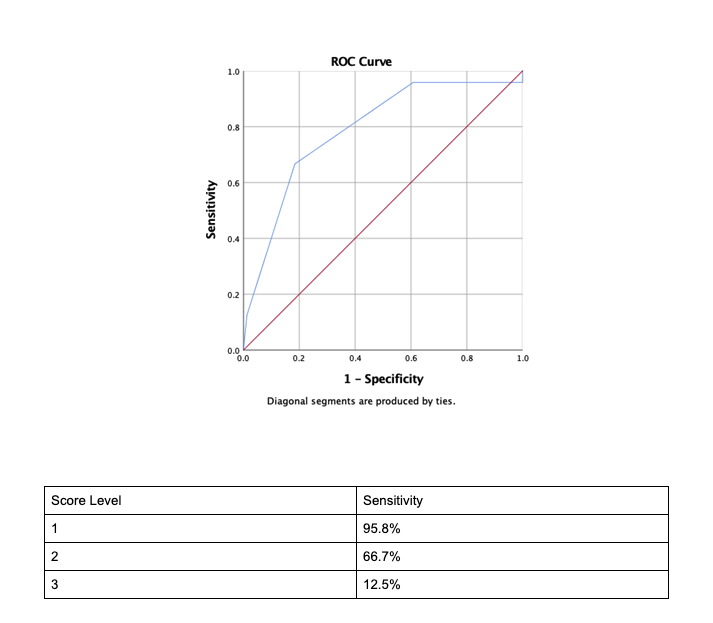Back
Poster, Podium & Video Sessions
Moderated Poster
MP44: Stone Disease: Surgical Therapy (including ESWL) III
MP44-08: A Novel Score to Predict Sepsis in Patients Undergoing Ureteral Stent Placement for Obstructing Stone and Presumed Urinary Tract Infection
Sunday, May 15, 2022
1:00 PM – 2:15 PM
Location: Room 228
David E. Hinojosa-Gonzalez*, Jason J. Lee, Christina S Kottooran, Alan J. Yaghoubian, Boston, MA, Nikil R. Uppaluri, Kate A. Hanson, Micheal S. Borofsky, Minneapolis, MN, Brian H. Eisner, Boston, MA

David Eugenio Hinojosa Gonzalez, MD
Massachusetts General Hospital
Poster Presenter(s)
Introduction: Urosepsis is the term given to sepsis originating from the urinary tract. Patients with obstructing ureteral stones and concomitant infection are at risk of developing urosepsis, even if adequately treated with emergent decompression. Sepsis carries an increased risk of shock, ICU admission and death. This study seeks to determine the risk factors and create a risk stratification score to predict sepsis.
Methods: With prior IRB-approval, a retrospective chart review of patients with obstructing stones and documented concern for urinary infection was conducted. Included patients underwent ureteral stent placement from July 2016 to April 2020 performed at two institutions. Patients who presented with hypotension requiring vasopressors, patients with solitary kidney or bilateral ureteral stones were excluded from the study. Patients were considered at risk for sepsis if 2 or more parameters of the Quick Sequential Organ Failure Assessment (qSOFA) were positive at any time point during their hospital course after stent placement.Patient characteristics and gathered data were modelled in a stepwise multivariable logistic regression. Data was analyzed in SPSS v.25
Results: A total of 187 patients were included, of which 24(12.8%) patients developed sepsis. Identified risk factors for sepsis through modelling were age older than 65 years, history of recurrent UTI and purulent urine noted during the procedure. Area Under the Curve (AUC) for the score was considered “good” at .789 p=.001. Table 1 displays the relationship between scoring and sensitivity. Binary logistic regression of the score revealed a significant OR of 4.12(2.2-7.73) p=0.001. Using “1” as a cutoff, the sensitivity was 95.8%, the specificity 39.3%, the positive predictive value 18.9% and the negative predictive value 98.5%.
Conclusions: Old age, history of UTI and purulent urine are significant predictors of sepsis in patients undergoing urinary decompression for ureteral stones with concomitant infection. Identification of a single of these risk factors can predict sepsis with 95.8% sensitivity.
Source of Funding: No funding was received

Methods: With prior IRB-approval, a retrospective chart review of patients with obstructing stones and documented concern for urinary infection was conducted. Included patients underwent ureteral stent placement from July 2016 to April 2020 performed at two institutions. Patients who presented with hypotension requiring vasopressors, patients with solitary kidney or bilateral ureteral stones were excluded from the study. Patients were considered at risk for sepsis if 2 or more parameters of the Quick Sequential Organ Failure Assessment (qSOFA) were positive at any time point during their hospital course after stent placement.Patient characteristics and gathered data were modelled in a stepwise multivariable logistic regression. Data was analyzed in SPSS v.25
Results: A total of 187 patients were included, of which 24(12.8%) patients developed sepsis. Identified risk factors for sepsis through modelling were age older than 65 years, history of recurrent UTI and purulent urine noted during the procedure. Area Under the Curve (AUC) for the score was considered “good” at .789 p=.001. Table 1 displays the relationship between scoring and sensitivity. Binary logistic regression of the score revealed a significant OR of 4.12(2.2-7.73) p=0.001. Using “1” as a cutoff, the sensitivity was 95.8%, the specificity 39.3%, the positive predictive value 18.9% and the negative predictive value 98.5%.
Conclusions: Old age, history of UTI and purulent urine are significant predictors of sepsis in patients undergoing urinary decompression for ureteral stones with concomitant infection. Identification of a single of these risk factors can predict sepsis with 95.8% sensitivity.
Source of Funding: No funding was received


.jpg)
.jpg)